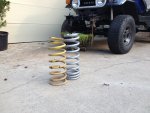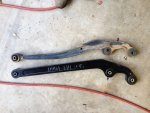RMP&O
Expedition Leader
your efforts to find the necessary parts combination to properly align this monster truck.
Even though I know you are being your normal troll self I am going to respond.
The truck has Old Man Emu coil springs, heavy duty. I was not aware that OME made "monster truck" springs. Perhaps you can enlighten us though.
The tires the truck came with, Wild Country 35x12.5R15 measured 33" with a tape. The new tires, Cooper STT are a 35x12.5R15 and measure 34.5". Do you consider this to be "monster truck", if so please explain.
The large majority of 80-series Cruisers running around with a lift have a 2.5" or there abouts OME lift. This amount of lift, ie 2-3", does not take castor to far out from stock. Roughly 3 degrees. On average the general consensus is that for every 1" of lift you lose 1* of castor. As is usual with my trucks, "general" doesn't apply. With 4" of lift my castor is out roughly 9*. Since most people only need to correct 3* or so an offset bushing is usually what is used to correct the castor and also the pinion angle. Other items on the market, which I should add help with up to 4" of lift are castor plates and drop brackets. When big castor correction is required, the 4-6+" lifts, new radius arms is generally used sometimes with the addition of offset busnings. The Slee arms for example, correct 8* of castor, more if you add bushings to them. Drop brackets are what the truck had on it when I picked it up. These are made by 4+ fab who sold a ton of their products through Man-a-Fre. They make brackets in 2",3",4" and possibly more. These brackets put the radius arms back into the stock location to correct the castor and the pinion angle, they do this by lowering the radius arm. However, I do not like them since they reduce ground clearance substantially. Also mine had been in since at least 2005 and when I removed them, I see obvious signs or slop by oval-ed out holes in the brackets. Myself, I like to lift a truck and retain as much of the stock components as I can. As such I am after a solution that resolves my castor issues along with my pinion angle yet does not use a combination of bushings, plates and brackets to get me there. I am all for using Slee radius arms to get the truck how I want it, however, after reading direct first hand accounts of aftermarket radius arms fixing castor but not pinion angle I am leaning away from that as my solution. The best solution for me is to cut & turn the front axle, this retains most of the stock components and sets castor plus pinion angle back to stock. However, due to the design of the front end on an 80 I can only gain a small amount with a C&T. A good friend proved a C&T will work on his truck as he did one and the results were stellar. However, he was in that 2-3" lift range. For me to be able to C&T as much as I want I need the tie rod relocated to the front of the axle. To relocate the tie rod I may very well need to relocate the panhard on the axle side and or both the frame side too. Hellfire knuckles are new knuckles that are manufactured with the mini-truck 80-series axle swap in mind, ie rock crawling. It makes for a much more buff knuckle and relocates the tie rod to in front of the axle as well as making it high steer. At this point a C&T will net much more castor gain. On top of this if I go one step farther I can torch all the brackets off the axle for radius arms, coil springs and panhard. I can then relocate these to match a stock set up, only lifted. The end result is increased strength, better ground clearance, stock components (for the most part) and a truck that is lifted 4" but drives like it is 100% stock.
I put a digital level on my axle before removing drop brackets, while attempting the C&T and after installing 3* bushings. So I am pretty familiar with what is going on as well as what it should be at stock. Ultimately, I am after castor about 1* over stock to compensate for larger than stock tires. Increased castors works good with larger tires. The larger the tire the more you should increase it over stock.
Now maybe I have more than 4" in front. I know I have OME J springs in the rear which should give 4" of lift, maybe 5" empty. It may have had a J spring in front at 4" of lift, I do not know. However, the truck had bad stink bug which I did not like. To level it out I lifted the front an additional 2" using a spacer. This gave me a truck that sits only 1* from level, which I like. I have heard reports of a J spring in the rear and it taking a 6" coil in front to level the truck out so it is possible I have more than 4" of lift in front. Why so much lift and why don't I just lower the truck? Because I like it this way! It is a standard OME J spring lift, it is nothing out of the ordinary or extreme. I am not loaded down though so I am getting the max amount of lift from the kit.
That clear things up for ya Zimm buddy? Should be clear to everybody now what is the deal when you lift an 80, what most people do about it and what I am doing about it.
Cheers


